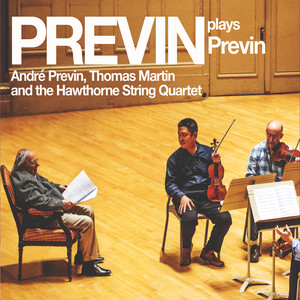
Previn Plays Previn
- 流派:Classical 古典
- 语种:其他
- 发行时间:2016-11-01
- 类型:录音室专辑
- 歌曲
- 时长
简介
The celebrated musical versatility of André Previn (b. 1929) is at the root of these two clarinet-friendly pieces, both written for BSO clarinetist Thomas Martin. André Previn the conductor of classical music has been working with the Boston Symphony Orchestra for more than thirty years now, and has also performed with many of its players as a pianist in chamber music settings. Although the BSO and subsets thereof have played Previn-the-composer’s chamber and orchestral music on many occasions, the last decade has brought several high-profile collaborations involving him as both conductor and composer. The first of these was his Violin Concerto Anne-Sophie, commissioned by the BSO and written for the orchestra and violinist Anne-Sophie Mutter, who premiered it under Previn’s direction in March 2001. Since then, the BSO commissioned and premiered his “orchestral nocturne” Owls (October 2008), and premiered his Double Concerto for violin, double bass, and orchestra, with Mutter and double bassist Roman Patkoló, in April 2007. The BSO also commissioned his Octet for Eleven for the Boston Symphony Chamber Players, who premiered it in October 2010. Previn has also played a few small-group jazz concerts at Tanglewood. It was during this period of heady collaboration that Tom Martin, who has a particular affinity for the clarinet’s jazz history, engaged André Previn-the-jazz-musician in conversation. Martin asked him to autograph an LP of Previn’s 1958 collaboration with Benny Goodman, “The King and Me” and was treated to anecdotes about those sessions, on which Previn was both composer and pianist. (“The King” is of course Goodman, the King of Swing, and the title is a takeoff on the Rodgers and Hammerstein musical The King and I.) A year later Martin, increasingly impressed with the range and depth of Previn’s musicianship (and especially the writing for winds in the Violin Concerto), asked the composer to write a new sonata for clarinet and piano, with Martin himself providing the commission. Previn agreed, but a couple of years passed before he could write the piece. The kick-start for its composition was an opportunity proposed by Terezín Music Foundation director Mark Ludwig for it to premiere at the 2010 Prague Spring Festival, where Martin was to perform along with the Hawthorne String Quartet. Ludwig suggested that Previn be the pianist in the premiere of the sonata. The organizers agreed and went one step further, naming Previn the featured composer for that season’s festival. Martin says his commission of the Previn Clarinet Sonata was not for himself, but for all clarinetists as an outstanding addition to the repertoire. The piece is in four sections—three are marked as movements, with the third section called an “Interlude.” The clarinet and piano are in every way equal partners throughout. The first movement features punchy rhythms with syncopation, capitalizing on the clarinet’s ability in rapid runs and big leaps. There are frequent points of direct conversation between the two instruments. Toward the end of the movement, the meter shifts from 4/4 to 3/4 for a lyrical section, the mood and style of which are a recurring idea. The second movement, introduced by a slow 3/4 piano melody that falls through three octaves, then a series of rich chords, defining the range of the movement. The clarinet’s melody is songlike at first, but an answering phrase adds intricate leaps and runs, which overflow into the piano. Previn takes advantage of the clarinet’s large compass with phrases beginning in the rich, low, so-called chalumeau register and rising to the instrument’s highest range. The bluesy interlude, in 12/8, expands from a short phrase in the clarinet, rising in range and in the piano’s increasingly active accompaniment. The finale begins in 5/8 time, anticipating the syncopations and meter changes throughout the movement. There are brief, clear references to the first movement, tying the whole piece together. The Clarinet Quintet originated naturally from Previn’s work with the Hawthorne Quartet in Prague. In a social gathering following one of the Prague events, Hawthorne founder and violist Mark Ludwig suggested, offhand, that Previn write a piece for Martin and the quartet, a configuration that has performed together on many occasions, including in Prague. Previn immediately agreed. The commission came from the Terezín Music Foundation, of which Ludwig is director, and “was made possible by Carol and Joseph Reich in loving memory of the two Townsend Friedmans.” “The André Previn Clarinet Quintet was commissioned by the Terezín Music Foundation in 2010 as a living memorial to the composers and musicians of the Terezín concentration camp who perished during the holocaust.” Thomas Martin and the Hawthorne String Quartet gave the world premiere of the piece on November 14, 2011, at a Terezín Music Foundation gala in Boston with the composer in attendance. The three-movement quintet begins with a suggestively lilting phrase in the strings, setting up the clarinet as the odd man out with a rapid arpeggio. The lilt is tempered by brief shifts into asymmetrical measures, and the back-and-forth keeps the music moving forward. The string quartet’s role is not that of accompaniment, but, as an ensemble, as a balanced partner for the clarinet; the roles for the individual strings are also balanced within the group, with individuals sometimes pairing up with the clarinet. Alternating between two kinds of music, the movement increases in tension and energy right up to the end. The marking of the middle movement, “Slow and lonely,” speaks for its mood. The movement is a freely lamenting aria for clarinet with quartet accompaniment. The finale is a perpetual-motion romp, a quick melody in the clarinet bouncing in syncopation off the quartet. More metrical shifts create imbalance and further excitement. A long coda ratchets up the energy further for a breathless close. Robert Kirzinger

